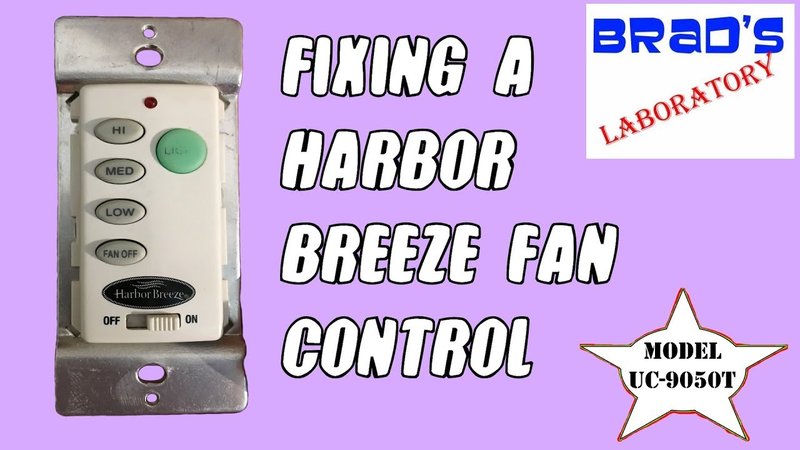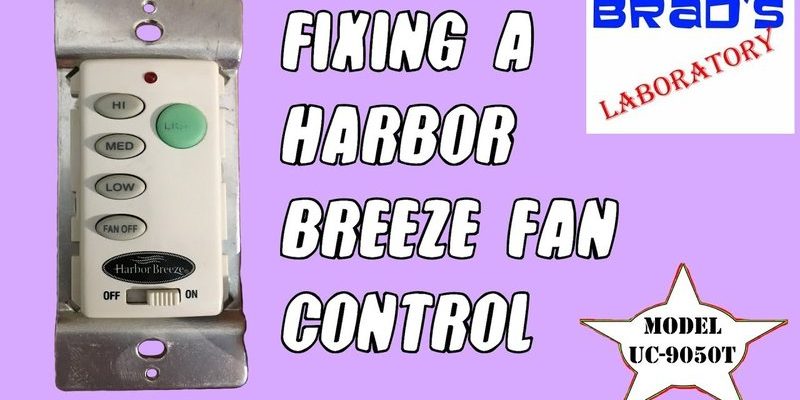
Harbor Breeze is a popular home brand, thanks to their affordable, easy-to-use ceiling fans. Their remotes are designed to let you adjust speed, lights, and sometimes even reverse the blade direction. But most homes already have a wall switch, and that can make things confusing. Will the two controls fight for dominance? Will your remote stop working if the switch is off? Let’s walk through the details, step by step, and solve the mystery.
Understanding How Ceiling Fan Remotes Work With Wall Switches
Think of the ceiling fan’s power like water flowing through pipes. The wall switch is the main valve. Flip it off, and nothing—remote or otherwise—can get through. When the switch is on, electricity flows to the fan, and now the remote can do its job. If you’ve ever clicked your remote and wondered why nothing happened, odds are the wall switch was turned off, cutting off all power.
With Harbor Breeze ceiling fans, the *remote receiver* is usually installed in the fan’s housing. This small box listens for signals from your remote. When the wall switch sends power to the fan, the receiver “wakes up” and takes over. So, think of the wall switch as a master key—but for day-to-day control, it’s the remote making things easy. If you want maximum flexibility, keep the switch on and use the remote for everything else. Of course, if you’re leaving for vacation, it’s smart to flip the wall switch off and cut power entirely.
Can You Use the Remote and Wall Switch Together?
Honestly, a lot of people get nervous about mixing controls. Will using both mess things up? Here’s the thing: *You absolutely can use a Harbor Breeze ceiling fan remote with a wall switch.* They’re designed to work together, but it helps to understand the limitations.
When the wall switch is ON, the fan is powered, and the *remote* lets you adjust speed, lights, or direction. If you flip the wall switch OFF, the remote can’t do anything, because there’s no power running to the fan or the receiver. Imagine trying to call someone who unplugged their phone—no matter how many times you dial, there’s nobody home.
For most people, the easiest setup is to leave the wall switch ON all the time and just use the remote. That way, you won’t accidentally “lock out” the remote by flipping the switch. Still, if you have kids, guests, or forgetful moments, don’t worry—turning the switch back on always “wakes up” the remote again.
Step-by-Step: Syncing and Pairing Your Harbor Breeze Remote
Let me explain how the remote *connects* to your fan (and why this matters if the remote or wall switch acts up). Inside your ceiling fan, there’s a tiny receiver box. The setup process—sometimes called *pairing* or *syncing*—connects your remote to this receiver. Most Harbor Breeze remotes use tiny DIP switches inside the battery compartment. Here’s what you’ll do:
- Turn off the wall switch to cut power to the fan. Safety first!
- Remove the fan canopy if you need to access the receiver (not always necessary but helpful during install or reset).
- Check the DIP switch settings in your remote and receiver. They need to match. Use a small screwdriver to move the switches if they don’t line up.
- Reinstall the battery in your remote and restore power at the wall switch.
- Test the remote—try light, speed, and direction functions. If nothing happens, double-check power at the wall switch and your DIP switch codes.
If the fan doesn’t respond, don’t panic. Double-check battery placement and switch positions. Sometimes, simply resetting the wall switch after syncing does the trick.
Troubleshooting Common Harbor Breeze Remote and Wall Switch Issues
You might be wondering what to do if your Harbor Breeze remote suddenly stops working, or the wall switch seems to “freeze” the fan. Here’s the reality: most problems are simple fixes. The most common? Dead batteries in the remote—easy to overlook, but swap them out and try again. Next, make sure your wall switch is ON. As mentioned earlier, if the switch is OFF, the receiver and remote can’t talk at all.
Other issues involve interference or a lost sync. For example, if you recently installed a new remote, check if the DIP switch codes got bumped. Or maybe a neighbor has the same fan—matching codes can cause crossed signals, leading to fans turning on by themselves (spooky, but fixable by adjusting your DIP switches).
If resetting everything doesn’t help, you might have a wiring issue at the wall. Check the connections, especially if your fan was installed recently. Loose wires can cause intermittent power, disrupting both the receiver and the remote functions. When in doubt, call an electrician.
It’s rare, but sometimes the remote receiver itself can fail after years of use. If you’ve ruled out batteries, switches, and codes, replacing the receiver may be your solution.
How to Reset a Harbor Breeze Ceiling Fan Remote
Sometimes remotes go rogue—refusing to sync or acting unpredictably. If your Harbor Breeze remote isn’t cooperating, a reset is usually the cure. Here’s what works for most models:
- Turn off the power at the wall switch or circuit breaker. Wait 10–20 seconds.
- Turn the power back on. Within 30 seconds, press and hold the “Fan” or “Sync” button (sometimes labeled “Learn”) on your remote for about 5 seconds.
- The fan should respond (usually a beep or light blink). That means you’re paired up again.
If your model uses DIP switches instead, simply make sure both switches (remote and receiver) have identical patterns, then power-cycle the fan through the wall switch. Always check batteries before resetting—otherwise, you might chase a ghost problem.
Comparing Universal Remotes vs. Harbor Breeze Original Remotes
Let’s say you lost your original Harbor Breeze remote. Can you just grab any universal fan remote at the store? Sometimes, yes—but not always. Here’s the scoop: Harbor Breeze ceiling fan remotes and receivers use specific frequency codes, so you’ll want a *universal remote* that’s compatible with Harbor Breeze models and has either adjustable DIP switches or a pairing mode.
- Universal remotes are handy if you’ve lost the original or want to control more than one fan. But setup can be tricky—check packaging for Harbor Breeze compatibility.
- Original remotes are plug-and-play. They’re matched to your fan’s receiver from the start, so no guesswork with frequencies or codes.
One tip: If you use a universal remote, keep the wall switch ON at all times, just as you would for the original. Otherwise, you’ll run into the same “no power” issues.
Pairing Harbor Breeze Ceiling Fan Remote After a Power Outage
Power outages occasionally mess up the pairing between your remote and the receiver. You may find your remote suddenly won’t work even though the batteries are fresh. Here’s a quick recovery:
- Once the power returns, flip the wall switch OFF for 10 seconds, then ON.
- Within 30 seconds, hold the “Fan” or “Pair” button for 5 seconds.
- If your light blinks or the fan runs, you’re synced up again.
No luck? Double-check your DIP switches. Outages can sometimes nudge them out of place. If problems continue, you may have a receiver issue—but that’s rare.
Tips for Everyday Use: Maximizing Convenience With Both Controls
Living with both a remote and a wall switch isn’t as complicated as it sounds—if you keep a few habits in mind. My favorite trick? Attach a small label to your wall switch: “Leave ON for fan remote.” It’s a simple reminder, especially for guests or little ones eager to flip switches.
- Use the wall switch for power, but keep it ON during normal use.
- Use the remote for daily adjustments: speed, lighting, direction.
- If leaving the house for extended periods, flip the switch OFF to save energy and reset the receiver if necessary.
You might find using both controls gives your home more flexibility—and, honestly, it makes life a bit more comfortable. No more guessing where the pull-chain landed or stumbling around in the dark.
Safety Tips and When to Call an Electrician
Whenever you’re dealing with electrical systems—even something as seemingly simple as a ceiling fan—safety comes first. Always turn off power at the breaker or wall switch before poking around wires or the receiver. Harbor Breeze ceiling fans are designed to be user-friendly, but if you run into anything that feels out of your comfort zone, don’t hesitate to call an electrician.
If your fan flickers, buzzes, or behaves unpredictably even after fixing batteries and switches, it could be a wiring problem. A professional can quickly spot loose connections, voltage drops, or even outdated hardware.
Remember: your ceiling fan isn’t just about comfort—it’s connected to your home’s main power. Err on the side of caution.
Wrapping Up: Finding the Best Setup for You
Pairing a Harbor Breeze ceiling fan remote with a wall switch isn’t just possible—it’s the most flexible way to control comfort in your space. Leave the wall switch ON for day-to-day convenience, and enjoy adjusting fan speed or lighting from wherever you are. If the remote ever stops working, start with the basics: check the batteries and make sure the wall switch is supplying power. Syncing, pairing, and a quick reset solve most issues.
Every home setup is a little different, so don’t be afraid to experiment with what feels right for your space. Whether you stick with the original remote or try a universal one, you’ve got options. And if all else fails, that wall switch is always there as your backup. Here’s to a cooler, easier, and smarter home—one button (or switch) at a time.
